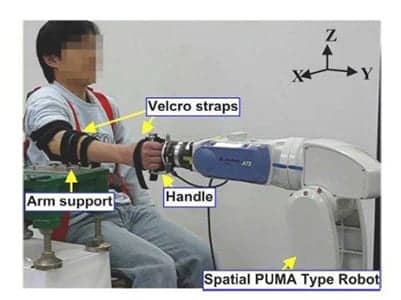
Pictured here is the experimental setup for the estimation of the 3 DOF human forearm and wrist impedance. (Photo courtesy of UNIST)
Scientists from Ulsan National Institute of Science and Technology (UNIST) have developed a new robotic tool to assess muscle overactivity and movement dysfunction in stroke survivors.
They suggest, in a study published recently in IEEE Transactions on Neural Systems and Rehabilitation Engineering, that their robotic-assisted rehabilitation therapy may help improve the stroke patients’ mobility.
The study was led by Professor Sang Hoon Kang of Mechanical, Aerospace and Nuclear Engineering at UNIST in collaboration with Professor Pyung-Hun Chang of DGIST and Dr Kyungbin Park of Samsung Electronics Co Ltd, according to a media release from UNIST.
In their study, Kang and the others on the team developed a rehabilitation robotic system that quantitatively measures the 3 degrees-of-freedom (DOF) impedance of human forearm and wrist in minutes.
Using their impedance estimation device, which they call the distal internal model based impedance control (dIMBIC)-based method, the team was able to accurately characterize the 3 DOF forearm and wrist impedance, including inertia, damping, and stiffness, for the first time, the release continues.
“The dIMBIC-based method can be used to assist in the quantitative and objective evaluation of neurological disorders, like stroke,” Kang says, in the release. “Findings from this study will open a new chapter in robot-assisted rehabilitation in the workplace accident rehabilitation hospitals, as well as in nursing homes and assisted living facilities.”
The research team expects that, in the long run, the proposed 3 DOF impedance estimation may promote wrist and forearm motor control studies and complement the diagnosis of the alteration in wrist and forearm resistance post-stroke by providing objective impedance values including cross-coupled terms, the release concludes.
[Source(s): Ulsan National Institute of Science and Technology (UNIST), Science Daily]


